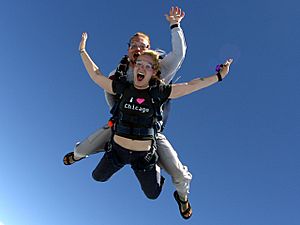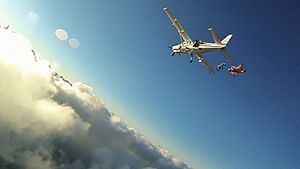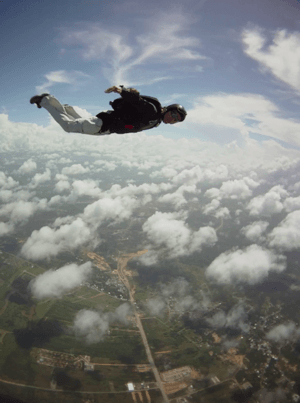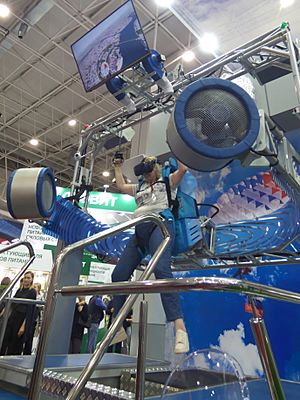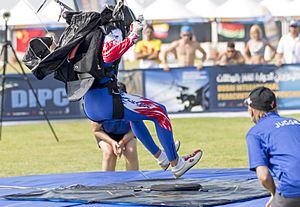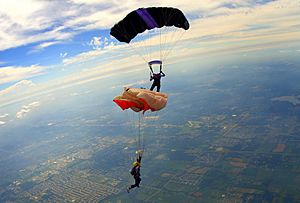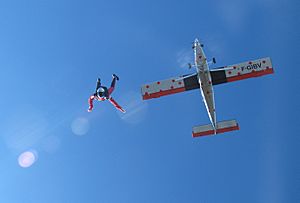Parachuting facts for kids
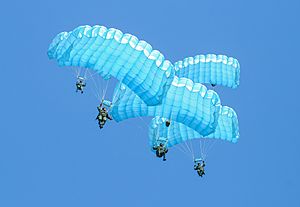
Four skydivers with deployed parachutes in Bex, Switzerland
|
|
| Highest governing body | Fédération Aéronautique Internationale |
|---|---|
| Characteristics | |
| Contact | No |
| Mixed-sex | Yes |
| Type | Air sports |
| Presence | |
| Country or region | Worldwide |
| Olympic | No |
| World Games | 1997 – 2017 |
Parachuting is a sport and a recreational activity that involves jumping from an aircraft using a parachute. It is widely considered an extreme sport due to the risks involved.
Contents
History
The first parachute jump in history was made by André-Jacques Garnerin, the inventor of the parachute, on 22 October 1797. Garnerin tested his contraption by leaping from a hydrogen balloon 3,200 feet (980 m) above Paris. Garnerin's parachute bore little resemblance to today's parachutes, however, as it was not packed into any sort of container and did not feature a ripcord. The first intentional free-fall jump with a ripcord-operated deployment was not made until over a century later by Leslie Irvin in 1919. While Georgia Broadwick made an earlier free-fall in 1914 when her static line became entangled with her jump aircraft's tail assembly, her free-fall descent was not planned. Broadwick cut her static line and deployed her parachute manually, only as a means of freeing herself from the aircraft to which she had become entangled.
The military developed parachuting as a way to save aircrew from emergencies aboard balloons and aircraft in flight, and later, as a way of delivering soldiers to the battlefield. Competitions date back to the 1930s, and it became an international sport in 1952.
Common uses
Parachuting is performed as a recreational activity and a competitive sport. In 2018, there were 3.3 million jumps in the US. Modern militaries utilize parachuting for the deployment of airborne forces and supplies. Special operations forces commonly employ parachuting, especially free-fall parachuting, as a method of insertion. Occasionally, forest firefighters, known as "smokejumpers" in the United States, use parachuting as a means of rapidly inserting themselves near forest fires in especially remote or otherwise inaccessible areas.
Manually exiting an aircraft and parachuting to safety has been widely used by aviators (especially military aviators and aircrew) and passengers to escape an aircraft that could not otherwise land safely. While this method of escape is relatively rare in modern times, it was occasionally used in World War I by German military aviators, and utilized extensively throughout the air wars of World War II. In modern times, the most common means of escape from an aircraft in distress is via an ejection seat.
Safety
In the US and in most of the western world, skydivers are required to wear two parachutes. The reserve parachute must be periodically inspected and repacked (whether used or not) by a certified parachute rigger (in the US, an FAA certificated parachute rigger every 180 days). Many skydivers use an automatic activation device (AAD) that opens the reserve parachute at a predetermined altitude if it detects that the skydiver is still in free fall. Depending on the country, AADs are often mandatory for new jumpers, and/or required for all jumpers regardless of their experience level. Some skydivers wear a visual altimeter, and some use audible altimeters fitted to their helmets.
Unsafe maneuvers
Injuries and fatalities occurring under a fully functional parachute usually happen because the skydiver performed unsafe maneuvers or made an error in judgement while flying their canopy, typically resulting in a high-speed impact with the ground or other hazards on the ground.
Winds
Changing wind conditions are another risk factor. In conditions of strong winds and turbulence during hot days, the parachutist can be caught in downdrafts close to the ground. Shifting winds can cause a crosswind or downwind landing which have a higher potential for injury due to the wind speed adding to the landing speed.
Canopy collisions
Another risk factor is that of "canopy collisions", or collisions between two or more skydivers under fully inflated parachutes. Canopy collisions can cause the jumpers' inflated parachutes to entangle with each other, often resulting in a sudden collapse (deflation) of one or more of the involved parachutes. When this occurs, the jumpers often must quickly perform emergency procedures (if there is sufficient altitude to do so) to "cut-away" (jettison) from their main canopies and deploy their reserve canopies. Canopy collisions are particularly dangerous when occurring at altitudes too low to allow the jumpers adequate time to safely jettison their main parachutes and fully deploy their reserve parachutes.
Equipment failure
Equipment failure may contribute to fatalities and injuries. Approximately one in 750 deployments of a main parachute result in a malfunction.
Base jumping

Parachuting disciplines such as BASE jumping or those that involve equipment such as wingsuit flying and sky surfing have a higher risk factor due to the lower mobility of the jumper and the greater risk of entanglement. For this reason, these disciplines are generally practised by experienced jumpers.
USPA member drop zones in the US and Canada are required to have an experienced jumper act as a "safety officer" (in Canada DSO – Drop Zone Safety Officer; in the U.S. S&TA – Safety and Training Advisor) who is responsible for dealing with jumpers who violate rules, regulations, or otherwise act in a fashion deemed unsafe by the appointed individual.
In many countries, either the local regulations or the liability-conscious prudence of the drop zone owners require that parachutists must have attained the age of majority before engaging in the sport.
The first skydive performed without a parachute was by stuntman Gary Connery on 23 May 2012 at 732 m.
Weather
Parachuting in poor weather, especially with thunderstorms, high winds, and dust devils can be a more dangerous activity. Reputable drop zones will suspend normal operations during inclement weather. In the United States, the USPA's Basic Safety Requirements prohibit solo student skydivers from jumping in winds exceeding 14 mph while using ram-air equipment. However, maximum ground winds are unlimited for licensed skydivers.
Visibility
As parachuting is an aviation activity under the visual flight rules, it is generally illegal to jump in or through clouds, according to the relevant rules governing the airspace, such as FAR105 in the US or Faldskærmsbestemmelser (Parachuting Ordinances) in Denmark. Jumpers and pilots of the dropping aircraft similarly bear responsibility of following the other VFR elements, in particular ensuring that the air traffic at the moment of jump does not create a hazard.
Training
Skydiving can be practised without jumping. Vertical wind tunnels are used to practise for free fall ("indoor skydiving" or "bodyflight"), while virtual reality parachute simulators are used to practise parachute control.
Beginning skydivers seeking training have the following options:
- Static line
- Instructor-assisted deployment (jumpmaster)
- Accelerated free fall
- Tandem skydiving
Parachute deployment
At a sport skydiver's deployment altitude, the individual manually deploys a small pilot-chute which acts as a drogue, catching air and pulling out the main parachute or the main canopy. There are two principal systems in use: the "throw-out", where the skydiver pulls a toggle attached to the top of the pilot-chute stowed in a small pocket outside the main container: and the "pull-out", where the skydiver pulls a small pad attached to the pilot-chute which is stowed inside the container.
Throw-out pilot-chute pouches are usually positioned at the bottom of the container – the B.O.C. deployment system – but older harnesses often have leg-mounted pouches. The latter are safe for flat-flying, but often unsuitable for freestyle or head-down flying.
In a typical civilian sport parachute system, the pilot-chute is connected to a line known as the "bridle", which in turn is attached to a small deployment bag that contains the folded parachute and the canopy suspension lines, which are stowed with rubber bands. At the bottom of the container that holds the deployment bag is a closing loop which, during packing, is fed through the grommets of the four flaps that are used to close the container. At that point, a curved pin that is attached to the bridle is inserted through the closing loop. The next step involves folding the pilot-chute and placing it in a pouch (e.g., B.O.C pouch).
Activation begins when the pilot-chute is thrown out. It inflates and creates drag, pulling the pin out of the closing loop and allowing the pilot-chute to pull the deployment bag from the container. The parachute lines are pulled loose from the rubber bands and extend as the canopy starts to open. A rectangular piece of fabric called the "slider" (which separates the parachute lines into four main groups fed through grommets in the four respective corners of the slider) slows the opening of the parachute and works its way down until the canopy is fully open and the slider is just above the head of the skydiver. The slider slows and controls the deployment of the parachute. Without a slider, the parachute would inflate fast, potentially damaging the parachute fabric and/or suspension lines, as well as causing discomfort, injury or even death of the jumper. During a normal deployment, a skydiver will generally experience a few seconds of intense deceleration, in the realm of 3 to 4 g, while the parachute slows the descent from 190 km/h (120 mph) to approximately 28 km/h (17 mph).
If a skydiver experiences a malfunction of their main parachute which they cannot correct, they pull a "cut-away" handle on the front right-hand side of their harness (on the chest) which will release the main canopy from the harness/container. Once free from the malfunctioning main canopy, the reserve canopy can be activated manually by pulling a second handle on the front left harness. Some containers are fitted with a connecting line from the main to reserve parachutes – known as a reserve static line (RSL) – which pulls open the reserve container faster than a manual release could. Whichever method is used, a spring-loaded pilot-chute then extracts the reserve parachute from the upper half of the container.
Competitions
World Championships are held every two years both Indoor and Outdoor in the competition disciplines Artistic Events (Freestyle and Freefly, indoor and outdoor), Canopy Formation (outdoor only), Canopy Piloting (outdoor only), Dynamic (indoor only), Formation Skydiving (indoor and outdoor), Paraski (outdoor only), Style & Accuracy Landing (outdoor only) and Wingsuit Flying (outdoor only). Continental Championships and World Cups can be held in alternate years.
Artistic events
There are now two competitive Artistic Events, Freestyle and Freefly. Freestyle teams consist of a performer and a videographer, Freefly teams have two performers and a videographer. Skysurfing is no longer a competitive event after insufficient competitors entered in two successive World Championships. The history of these events is on this Freeflying page.
Accuracy landing
Often called "Classic accuracy", this is an individual or team contest performed under an open parachute. The aim is to touch down on a target whose center is 2 cm in diameter. The target can be a deep foam mattress or an air-filled landing pad. An electronic recording pad of 32 cm in diameter is set in the middle. It measures score in 1 cm increments up to 16 cm and displays result just after landing.
The first part of any competition takes place over 8 rounds. Then in the individual competition, after these 8 selective rounds, the top 25% jump a semi-final round. After the semi-final round, the top 50% are selected for the final round. The competitor with the lowest cumulative score is declared the winner.
Competitors jump in teams of 5 maximum, exiting the aircraft at 1,000 or 1,200 meters and opening their parachutes sequentially to allow each competitor a clear approach to the target.
This sport is unpredictable because weather conditions play a very important part. So classic accuracy requires high adaptability to aerology and excellent steering control.
It is also the most interesting discipline for spectators due to the closeness of action (a few meters) and the possibility to be practiced everywhere (sport ground, stadium, urban place...). Today, classic accuracy is the most practiced (in competition) discipline of skydiving in the world.
Canopy formation
Previously called Canopy Relative Work, or CREW for short, is a skydive where the participants open their parachutes very quickly after leaving the aircraft with the intention of flying in close proximity to each other. The goal is to create various formations by "docking" with other parachutists on the jump. The dock is often accomplished by placing one's feet into the lines of another person's parachute. Formations require at least 2 people, but can have many more.
Due to the close proximity of the canopies, care has to be taken by all participants to ensure the safety of the jump. It is common for a CREW jumper to carry a hook knife to use in case they become entangled in another jumper's lines.
Formation skydiving
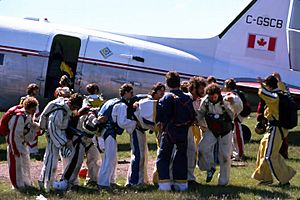
Formation Skydiving (FS) was born in California, USA during the 1960s. The first documented skydiving formation occurred over Arvin, California in March 1964 when Mitch Poteet, Don Henderson, Andy Keech and Lou Paproski successfully formed a 4-man star formation, photographed by Bob Buquor. This discipline was formerly referred to in the skydiving community as Relative Work, often abbreviated to RW, Relly or Rel.
Style
Style can be considered as the sprint of parachuting. This individual discipline is played in free fall. The idea is to take maximum speed and complete a pre-designated series of maneuvers as fast and cleanly as possible (speed can exceed 400 km/h/250 mph). Jumps are filmed using a ground-based camera (with an exceptional lens to record the performance).
Performance is timed (from the start of the manoeuvre until its completion) and then judged in public at the end of the jump. Competition includes 4 qualifying rounds and a final for the top 8. Competitors jump from a height of 2200 m to 2500 m. They rush into an acceleration stage for 15 to 20 seconds and then run their series of manoeuvres benefiting to the maximum of the stored speed. Those series consist of Turns and Back-Loops to achieve in a pre-designated order. The incorrect performance of the manoeuvres gives rise to penalties that are added at run time.
The performance of the athlete is defined in seconds and hundredths of a second. The competitor with the lowest cumulative time is declared the winner.
Drop zones
In parachuting, a drop zone or DZ is most technically the area above and around a location where a parachutist freefalls and expects to land. In common use, it often refers to the totality of a skydiving operation (a business). And the area wherein parachutists land will be referred to as the "landing area". The drop zone is usually situated beside a small airport, often sharing the facility with other general aviation activities. Drop zone staff may include the DZO (drop zone operator or owner), manifest, pilots, instructors, coaches, cameramen, packers, riggers and other general staff.
Equipment
A parachutist's equipment consists of at least three, usually four components, a container/harness system, a main canopy, a reserve canopy and frequently an automatic activation device (AAD) as well. Other items may include a helmet, goggles, jumpsuit, altimeter, and gloves. An increasing number of skydivers wear cameras, like GoPros, to record their skydives.
Costs in the sport are not trivial. The market is not large enough to permit the steady lowering of prices that is seen with some other equipment like computers. A new container/harness system can cost between US$1,500 and US$3,500, main canopies for the experienced parachutist can cost between $2,000 and US$3,600, reserve canopies cost between US$1,500 and US$2,500 and AADs US$1,000 cost. Higher performance and tandem parachutes cost significantly more, whilst large docile student parachutes often cost less.
Most parachuting equipment is ruggedly designed and is enjoyed by several owners before being retired. A rigger is trained to spot signs of damage or misuse. Riggers also keep track of industry product and safety bulletins, and can, therefore, determine if a piece of equipment is up-to-date and serviceable.
Traveling with a parachute
When traveling by plane, parachutes' owners may not want to put their parachute in the baggage hold in order to avoid possible deterioration due to possible incorrect handling by airport operators. In such case, a resulting malfunction in a future use of the parachute could be dramatic.
However, almost all parachutes contain an automatic activation device (AAD), thus bringing a parachute to the plane's cabin might cause issues when going through airport security. AADs can contain either void or pyrotechnic load, and the rest of the parachute also consists of several very uncommon metallic parts and cables, all of which could trigger scanners of the security screening.
In order to justify the presence of "suspicious" content inside the parachute (explosive, vacuum, metal pieces, cables), travelers are encouraged to announce that they are traveling with a parachute when they buy their airplane ticket, and to produce the following documents when asked by the airport security's staff :
- The AAD's explanation card that shows and describes what is seen on X-ray monitors
- Documents from a country, airplane company, or airport officials themselves, that denote the exclusion of such devices from the forbidden items
- The parachute's constructor book detailing the anatomy of the whole bag. Similarly to the AAD's card, it can help showing the purpose of all what could raise awareness of the staff
National skydiving associations usually list on their websites a piece of advice concerning this matter.
Record free fall parachute jumps
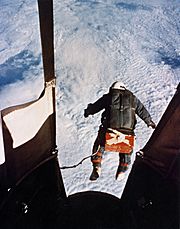
In 1914, while doing demonstrations for the U.S. Army, a parachute pioneer named Tiny Broadwick deployed her chute manually, thus becoming the first person to jump free-fall.
According to the Guinness Book of Records, Eugene Andreev (USSR) holds the official FAI record for the longest free-fall parachute jump after falling for 24,500 metres (80,400 ft) from an altitude of 25,458 metres (83,524 ft) near the city of Saratov, Russia, on 1 November 1962. Although later on jumpers would ascend higher altitudes, Andreev's record was set without the use of a drogue chute during the jump and therefore remains the longest genuine free fall record.
During the late 1950s, Captain Joseph Kittinger of the United States was assigned to the Aerospace Medical Research Laboratories at Wright-Patterson AFB in Dayton, Ohio. For Project Excelsior (meaning "ever upward", a name given to the project by Colonel John Stapp), as part of research into high altitude bailout, he made a series of three parachute jumps wearing a pressurized suit, from a helium balloon with an open gondola.
The first, from 76,400 feet (23,300 m) in November 1959 was a near tragedy when an equipment malfunction caused him to lose consciousness, but the automatic parachute saved him (he went into a flat spin at a rotational velocity of 120 rpm; the g-force at his extremities was calculated to be over 22 times that of gravity, setting another record). Three weeks later he jumped again from 74,700 feet (22,800 m). For that return jump Kittinger was awarded the A. Leo Stevens parachute medal.
On 16 August 1960 he made the final jump from the Excelsior III at 102,800 feet (31,300 m). Towing a small drogue chute for stabilization, he fell for 4 minutes and 36 seconds reaching a maximum speed of 614 mph (988 km/h) before opening his parachute at 14,000 feet (4,300 m). Pressurization for his right glove malfunctioned during the ascent, and his right hand swelled to twice its normal size. He set records for highest balloon ascent, highest parachute jump, longest drogue-fall (4 min), and fastest speed by a human through the atmosphere.
The jumps were made in a "rocking-chair" position, descending on his back, rather than the usual arch familiar to skydivers, because he was wearing a 60-pound (27 kg) "kit" on his behind and his pressure suit naturally formed that shape when inflated, a shape appropriate for sitting in an airplane cockpit. For the series of jumps, Kittinger was decorated with an oak leaf cluster to his Distinguished Flying Cross and awarded the Harmon Trophy by President Dwight Eisenhower.
In 2012, the Red Bull Stratos mission took place. On 14 October 2012, Felix Baumgartner broke the records previously set by Kittinger for the highest free fall, the highest manned helium balloon flight, and the fastest free fall; he jumped from 128,100 feet (39,000 m), reaching 833.9 mph (1342 km/h) - Mach 1.24, faster than the speed of sound. Kittinger was a member of the mission control and helped design the capsule and suit that Baumgartner ascended and jumped in.
On 24 October 2014, Alan Eustace broke the record previously set by Baumgartner for the highest fall. He jumped from a height of 135,908 feet (41,425 m) and fell with a drogue chute for 4+1⁄2 minutes.
Other records
Individual jumps
- Don Kellner holds the record for the most parachute jumps up to 2021, with a total of 46,355 jumps. He made his last eight skydives on May 1, 2021, in Hazleton, Pennsylvania, before his death from cancer on the following July 22, aged 85.
- In 1929, U.S. Army Sergeant R. W. Bottriell held the world's record for the most parachute jumps with 500. At that number, Bottriell stopped parachuting and became a ground instructor.
- Cheryl Stearns (U.S.) holds the record for the most parachute descents by a woman, with a total of 20,000 in August 2014, as well as the most parachute jumps made in a 24-hour period by a woman—352 jumps from 8–9 November 1995.
- Erin Hogan became the world's youngest sky diver as of 2002, when she tandem jumped at age 5. (Beaten in 2003 by age 4 Kiwi)
- Bill Dause holds the record for the most accumulated freefall time with over 420 hours (30,000+ jumps).
- Jay Stokes holds the record for most parachute descents in a single day at 640.
- The oldest female solo skydiver was Dilys Price. On 13 April 2013 she carried out the oldest solo parachute jump by a woman from Langar Airfield, Nottingham, UK when she was 80 years and 315 days.
- The oldest female tandem skydiver is Irene O'Shea. She made a tandem parachute jump on 9 December 2018 from an altitude of 4,000 m (13,000 ft) over Adelaide, Australia, at the age of 102 years. Her jump raised money and awareness for the Motor Neuron Disease Association of Southern Australia.
- The oldest male tandem skydiver, according to Guinness Book of World Records, is Bryson William Verdun Hayes (born 6 April 1916), who achieved the feat on 14 May 2017 at the age of 101 years 38 days. Bryson Hayes had earlier become the oldest ever UK sky diver, achieving the feat on 11 April 2016 when he was 100 years old.
- The record was previously held by Armand Gendreau (born 24 June 1913) who made a tandem parachute jump above Notre-Dame-de-Lourdes, Québec, Canada, on 27 June 2014 at the age of 101 years 3 days
- In July 2017, 102-year-old Kenneth Meyer (born 5 February 1915) became the oldest person to skydive. As of December 2018, his achievement is under review by Guinness World Records and Hayes continues to hold the Guinness record for the oldest male tandem skydiver.
- The oldest solo United States skydiver is Milburn Hart from Seattle, Washington. He was 96 years old when achieved this feat by making a solo jump in February 2005.
- On 14 October 2012, after seven years of planning, Felix Baumgartner (Austria) achieved the highest jump altitude, the highest freefall and the highest speed in freefall. He also became the first skydiver to break the sound barrier. He started from Roswell, New Mexico, USA.
- Australian stunt parachutist, Captain Vincent Taylor, received the unofficial record for a lowest-level jump in 1929 when he jumped off a bridge over the San Francisco Bay whose center section had been raised to 135 feet (41 meters).
Group jumps
- World's record for the most tandem parachute jumps in a 24-hour period is 403. This record was set at Skydive Hibaldstow on 10 July 2015, in memory of Stephen Sutton.
- World's largest formation in free-fall: 8 February 2006 in Udon Thani, Thailand (400 linked persons in freefall).
- World's largest female-only formation: Jump for the Cause, 181 women from 26 countries who jumped from nine planes at 17,000 feet (5,200 meters), in 2009.
- World's largest head down formation (vertical formation): 31 July 2015 at Skydive Chicago in Ottawa, Illinois, U.S. (164 linked skydivers in head to Earth attitude):
- Largest female head down formation (vertical formation): 30 November 2013 at Skydive Arizona in Eloy, Arizona, U.S. (63 linked skydivers in head to Earth attitude).
- European record: 13 August 2010, Włocławek, Poland. Polish skydivers broke a record when 102 people created a formation in the air during the Big Way Camp Euro 2010. The skydive was their fifteenth attempt at breaking the record.
- World's largest canopy formation: 100, set on 21 November 2007 in Lake Wales, Florida, U.S.
- Largest wingsuit formation: 22 September 2012, Perris Valley, California, U.S. (100 wingsuit jumpers).
- Largest all-blind skydiving formation: 2, with Dan Rossi and John "BJ" Fleming on 13 September 2003.
- The oldest civilian parachute club in the world is The Irish Parachute Club, founded in 1956 by Freddie Bond and located in Clonbullogue, Co. Offaly, Ireland.
- The oldest civilian parachute club in the USA is The Peninsula Skydivers Skydiving Club, founded in 1962 by Hugh Bacon Bergeron, located in West Point, VA,
- In September 1980, the world record night dive was performed at Perris, California, USA, as the last night world record before it was eliminated as a separate category by the Fédération Aéronautique Internationale. It has since been reinstated in 2017.
See also
 In Spanish: Paracaidismo para niños
In Spanish: Paracaidismo para niños
- List of paratrooper forces
- Banzai skydiving
- Dolly Shepherd
- Parachute landing fall
- Paratrooper
- Space diving
- Speed skydiving
- Space Games
- The First School of Modern SkyFlying
- Skydiver day
- High-altitude military parachuting


